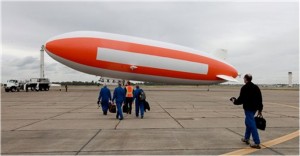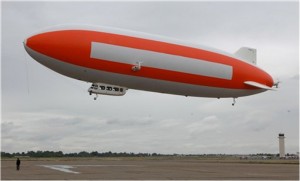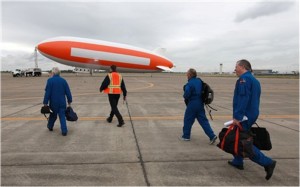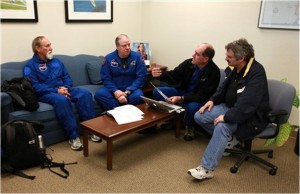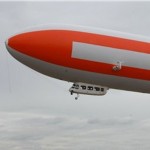 Source: SFGate.com – The San Francisco Chronicle
Source: SFGate.com – The San Francisco Chronicle
A group of scientists took to the skies in an airship Thursday in search of meteorites that rained over California’s gold country last month.
It’s the latest hunt for extraterrestrial fragments from the April 22 explosion that was witnessed over a swath of Northern California and Nevada.
Treasure hunters have swarmed the Sierra Nevada foothills over the past two weeks, snatching up pieces of meteorites. Most of the recovered space rocks have been tiny, with the largest weighing in at 19 grams, or the weight of one AA battery.
Wearing blue flight suits, four NASA researchers walk to the zeppelin, Eureka, at McClellan Air Park in Sacramento, Calif., that will be used to search for pieces of a meteorite Thursday, May 3, 2012. The researches from NASA and the SETI Institute are hoping to spot sites where large fragments landed after a meteor exploded in the atmosphere over the Sierra Nevada in late April.
Researchers from NASA and the nonprofit SETI Institute in Mountain View, Calif., were on the lookout for larger fragments. After a brief weather delay, they took off from a Sacramento airfield aboard an airship outfitted with sensors and cameras.
From the air, scientists scoured the terrain for places where sizable meteorites might have scattered. The survey took them over the area where James W. Marshall first discovered gold in California in 1848. Once they pinpoint possible impact sites, they plan to follow up with a search party.
Peter Jenniskens, right, the NASA scientist in charge of a group of researchers searching for pieces of a meteorite, walk to the zeppelin, Eureka, at McClellan Air Park in Sacramento, Calif., Thursday, May 3, 2012. Researchers from NASA and the SETI Institute are using the slow moving airship in hope of spotting sites where large fragments landed after a meteor exploded in the atmosphere over the Sierra Nevada in late April.
“Only small pieces have been found. There has to be big pieces out there,” SETI Institute meteor astronomer Peter Jenniskens said before the trip. “We’re just hoping to collect more meteorites for research.”
Days after the approximately 154,300-pound meteor plunged through Earth’s atmosphere with a loud sonic boom that was heard from Sacramento to Las Vegas, Jenniskens organized a team and found a 4-gram meteorite in the parking lot of a park.
Carrying scientists and researchers, the zeppelin, Eureka lifts off from McClellan Air Park in Sacramento, Calif., to search for pieces of a meteorite, Thursday, May 3, 2012. The researchers are using an aerial search hoping to locate sites where large fragments landed after a meteor exploded in the atmosphere over the Sierra Nevada in late April.
NASA estimated the minivan-sized meteor released energy equal to one-third the explosive power of the atomic bomb dropped on Hiroshima during World War II. An event this size occurs once a year usually over unpopulated areas.
NASA researchers walk to the zeppelin, Eureka, at McClellan Air Park in Sacramento, Calif., that will be used to search for pieces of a meteorite Thursday, May 3, 2012. The researchers from NASA and the SETI Institute are hoping to spot sites where large fragments landed after a meteor exploded in the atmosphere over the Sierra Nevada in late April.
Initial inspection of rock fragments indicates this type of meteorite is among the oldest, dating to the solar system’s birth 4 billion to 5 billion years ago.
NASA scientist Peter Jenniskens, second from right, leaders of a group of researchers searching for pieces of a meteorite, goes over the search plan before take off from McClellan Air Park in Sacramento, Calif., Thursday, May 3, 2012. Researchers from NASA and the SETI Institute are using the zeppelin, Eureka for their aerial search in hope of spotting sites where large fragments landed after a meteor exploded in the atmosphere over the Sierra Nevada in late April.
Source: SFGate.com – The San Francisco Chronicle


